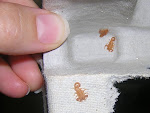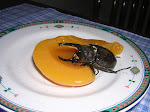
No Pacific NW scorpions were found while at the cabin at Shotpouch Creek last weekend. The habitat just wasn't there for U. mordax, which is associated with rocky slopes. But there were plenty of other critters and plants that kept us busy and writing.
The Trillium Project seeks to connect people with nature, particularly through writing. To do this, the project makes use of a 40-acre nature reserve on which they've built a very nice cabin for guests to stay. A friend and I submitted a proposal to go there and write. We thought it would be neat to provide a dual perspective of nature: 1) a biologist's perspective; 2) an "everyday person's" perspective...both based on the same experiences.

 My first response to the cabin at Shotpouch Creek was awe. It blends in with the land like it was always meant to be there. The lawn wasn't "mowed" and the nature around isn't corralled for aesthetics. But somehow it looked loved and well tended. (Above/top: the view out the kitchen, with one of the other cabin guests taking a late morning siesta in her sleeping bag on the deck. Above: a grand piano overlooks a wall of windows...what better place to teach a friend to play Heart and Soul?)
My first response to the cabin at Shotpouch Creek was awe. It blends in with the land like it was always meant to be there. The lawn wasn't "mowed" and the nature around isn't corralled for aesthetics. But somehow it looked loved and well tended. (Above/top: the view out the kitchen, with one of the other cabin guests taking a late morning siesta in her sleeping bag on the deck. Above: a grand piano overlooks a wall of windows...what better place to teach a friend to play Heart and Soul?) Spearmint grows in abundace just outside, so we helped ourselves and started off the morning right: fresh-picked-spearmint tea.
Spearmint grows in abundace just outside, so we helped ourselves and started off the morning right: fresh-picked-spearmint tea. We only had 24 hours to spare, given work and graduate studies. But it was enough to replenish, restore, write, an of course explore.
We only had 24 hours to spare, given work and graduate studies. But it was enough to replenish, restore, write, an of course explore. Most of what we saw, picked, tasted, and heard fell into the "hey neato!" category. I found the country kid in me taking over, and at times I had to work hard to think like the scientist I went there to represent. (Above: crab spider, family Thomisidae, dangling on dandelion.)
Most of what we saw, picked, tasted, and heard fell into the "hey neato!" category. I found the country kid in me taking over, and at times I had to work hard to think like the scientist I went there to represent. (Above: crab spider, family Thomisidae, dangling on dandelion.) It was so nice to be surrounded by the sounds and behaviors I recall from my childhood, and later as an adult while working as a field wildlife technician. Summer research would always kick off in May in the Pacific NW, and on this May day at the Cabin at Shotpouch Creek there were many of the same birds and plants exactly as I remember them. From counter-calling wilson's warblers, cryptic nest-building winter wrens and swaths of stinging nettle, to the grandiose mating displays of rufous hummingbirds...how I've missed them! It felt, in a very sweet way, like a family reunion.
It was so nice to be surrounded by the sounds and behaviors I recall from my childhood, and later as an adult while working as a field wildlife technician. Summer research would always kick off in May in the Pacific NW, and on this May day at the Cabin at Shotpouch Creek there were many of the same birds and plants exactly as I remember them. From counter-calling wilson's warblers, cryptic nest-building winter wrens and swaths of stinging nettle, to the grandiose mating displays of rufous hummingbirds...how I've missed them! It felt, in a very sweet way, like a family reunion. My friend, Laura, supplied the "everyday person" perspective. Even though she's a brilliant physical oceanographer, and graduated from MIT, she new to Pacific NW flora and fauna, and is largely unexposed to the study of living things. Plus, living things tend to fascinate and terrify her in ways I can't help laughing at (even starfish are not exempt from her terror factor).
My friend, Laura, supplied the "everyday person" perspective. Even though she's a brilliant physical oceanographer, and graduated from MIT, she new to Pacific NW flora and fauna, and is largely unexposed to the study of living things. Plus, living things tend to fascinate and terrify her in ways I can't help laughing at (even starfish are not exempt from her terror factor). Laura was stoic, without a hint of fear of the birds, bugs or plants. I even convinced her to experience stinging nettle. We rubbed our wrists on the thin spiked stalks and relished the stinging welts that followed, her in awe and I in reminiscence.
 In spite of being a native to the Pacific NW and having so much time in the woods, I had never picked fiddleheads...until now. Fiddleheads are the new growths on fern, the soft tops that curl over and look like -- you got it -- fiddles. The sword fern in particular has good-eating fiddleheads I've heard, and it was incredibly abundant in the woods around the cabin. Knowing the reserve was not crawling with illegal trespassing fiddlehead pickers (as I've seen elsewhere), I snapped a small handful and hoped the indulgence would not be noticed by the landscape. Nutty and firm, we added them diced to our scrambled eggs. Check out your local farmer's market if you're interested in trying fiddleheads. Though sword fern are an abundant plant, they're native and are relied on by a variety of native birds for nesting substrate. So I don't want to encourage people to take to the forests for picking.
In spite of being a native to the Pacific NW and having so much time in the woods, I had never picked fiddleheads...until now. Fiddleheads are the new growths on fern, the soft tops that curl over and look like -- you got it -- fiddles. The sword fern in particular has good-eating fiddleheads I've heard, and it was incredibly abundant in the woods around the cabin. Knowing the reserve was not crawling with illegal trespassing fiddlehead pickers (as I've seen elsewhere), I snapped a small handful and hoped the indulgence would not be noticed by the landscape. Nutty and firm, we added them diced to our scrambled eggs. Check out your local farmer's market if you're interested in trying fiddleheads. Though sword fern are an abundant plant, they're native and are relied on by a variety of native birds for nesting substrate. So I don't want to encourage people to take to the forests for picking. For more information on the Trillium Project and writers-in-residency programs held at the cabin at Shotpouch Creek, please visit the Spring Creek Project homepage. Thanks to the organizers of the Spring Creek Project for allowing us a very memorable stay.
For more information on the Trillium Project and writers-in-residency programs held at the cabin at Shotpouch Creek, please visit the Spring Creek Project homepage. Thanks to the organizers of the Spring Creek Project for allowing us a very memorable stay.









+reduced.jpg)

